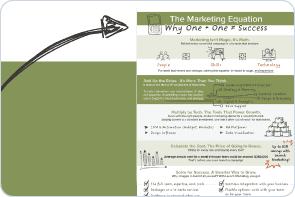Marketing Resources for B2B Growth
Explore our comprehensive library of marketing resources designed to help B2B leaders drive growth and generate results. Access guides, checklists, templates, and actionable insights to optimize your marketing strategy and accelerate business success.

Marketing Resources for B2B Growth
Explore our comprehensive library of marketing resources designed to help B2B leaders drive growth and generate results. Access guides, checklists, templates, and actionable insights to optimize your marketing strategy and accelerate business success.

Marketing Resources for B2B Growth
Explore our comprehensive library of marketing resources designed to help B2B leaders drive growth and generate results. Access guides, checklists, templates, and actionable insights to optimize your marketing strategy and accelerate business success.

Resources to grow smarter.
Infographic

The Real Cost of Marketing: The Marketing Equation
Marketing isn't magic. It's math. Discover the real cost of marketing with this marketing equation and how you can put your dollars where they count most.
Checklist

Unlocking Business Growth Your Go-To Checklist for Lead Generation That Works
Ready to turn your marketing efforts into measurable growth? This comprehensive checklist outlines the essential activities every marketing team should implement to generate more leads, and more revenue.
eBook

How B2B Leaders Can Gain (or Regain) Marketing Momentum
Is your marketing strategy stuck in neutral? This executive guide helps B2B leaders assess their current efforts and uncover practical marketing strategies to build lasting momentum. Discover what’s holding your strategy back, and how to fix it.
News
News
News

B2B Tech Marketing Agency, Launch Marketing, Announces Its Acquisition by Chris Leger
Launch Marketing announced its acquisition by Chris Leger who will join the B2B tech marketing agency as the new CEO.
4810 Spicewood Springs Road, Suite 250, Austin, TX 78759
We deliver bold B2B marketing that drives growth.
Ready to get started?
Copyright © 2025 Launch Marketing.
4810 Spicewood Springs Road, Suite 250, Austin, TX 78759
We deliver bold B2B marketing that drives growth.
Copyright © 2025 Launch Marketing.
4810 Spicewood Springs Road, Suite 250, Austin, TX 78759
We deliver bold B2B marketing that drives growth.
Copyright © 2025 Launch Marketing.